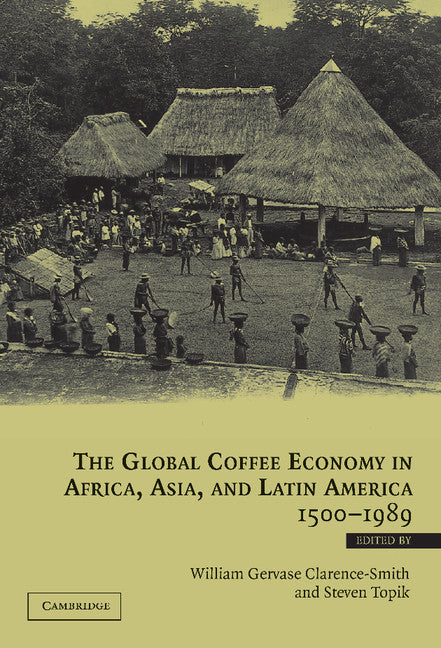Freshly Printed - allow 8 days lead
Couldn't load pickup availability
The Global Coffee Economy in Africa, Asia, and Latin America, 1500–1989
This 2003 volume analyzes the markets, societies, technology and colonial cultures involved in the coffee economy.
William Gervase Clarence-Smith (Edited by), Steven Topik (Edited by)
9780521818513, Cambridge University Press
Hardback, published 16 June 2003
506 pages, 10 maps 28 tables
22.9 x 15.2 x 3.2 cm, 0.91 kg
'… a geographical tour-de-force …'. Journal of African History
Coffee beans grown in Brazil, Colombia, Vietnam, or one of the other hundred producing lands on five continents remain a palpable and long-standing manifestation of globalization. For five hundred years coffee has been grown in tropical countries for consumption in temperate regions. This 2003 volume brings together scholars from nine countries who study coffee markets and societies over the last five centuries in fourteen countries on four continents and across the Indian and Pacific Oceans, with a special emphasis on the nineteenth and early twentieth centuries. The chapters analyse the creation and function of commodity, labour, and financial markets; the role of race, ethnicity, gender, and class in the formation of coffee societies; the interaction between technology and ecology; and the impact of colonial powers, nationalist regimes, and the forces of the world economy in the forging of economic development and political democracy.
Part I. Introduction: Coffee and Global Development Steven Topik and William Gervase Clarence-Smith
Part II. Origins of the World Coffee Economy: 1. The integration of the world coffee market Steven Topik
2. Coffee in the Red Sea area from the 16th to the 19th century Michel Tuchscherer
3. The origins and development of coffee production in Réunion and Madagascar, 1711–1960 Gwyn Campbell
4. The coffee crisis in Asia, Africa, and the Pacific, 1870–1914 William Gervase Clarence-Smith
5. The historical construction of quality and competitiveness: a preliminary discussion of coffee commodity chains Mario Samper K.
Part III. Peasants: Race, Gender, and Property: 6. Coffee cultivation in Java, 1830–1907 M. R. Fernando
7. Labor, race and gender on the coffee plantations in Ceylon (Sri Lanka), 1834–80 Rachel Kurien
8. Coffee and indigenous labor in Guatemala, 1871–1980 David McCreery
9. Patriarchy from above, patriarchy from below, debt peonage on Nicaraguan coffee estates, 1870–1930 Elizabeth Dore
10. Small farmers and coffee in Nicaragua Julie Charlip
Part IV. Coffee, Politics, and State Building: 11. Coffee and recolonization of Highland Chiapas, Mexico: Indian communities and plantation labor, 1892–1912 Jan Rus
12. Comparing coffee production in Cameroon and Tanzania, c.1900 to 1960s: land, labor and politics Andreas Eckert
13. Smaller is better: a consensus of peasants and bureaucrats in colonial Tanganyika Kenneth Curtis
14. On paths not taken: commercial capital and coffee production in Costa Rica Lowell Gudmundson
15. Coffee and development of the Rio de Janeiro economy: 1888–1920 Hildete Pereira de Melo
Part V. Conclusion: New Propositions and a Research Agenda Steven Topik and William Gervase Clarence-Smith.
Subject Areas: Economic history [KCZ], General & world history [HBG]


